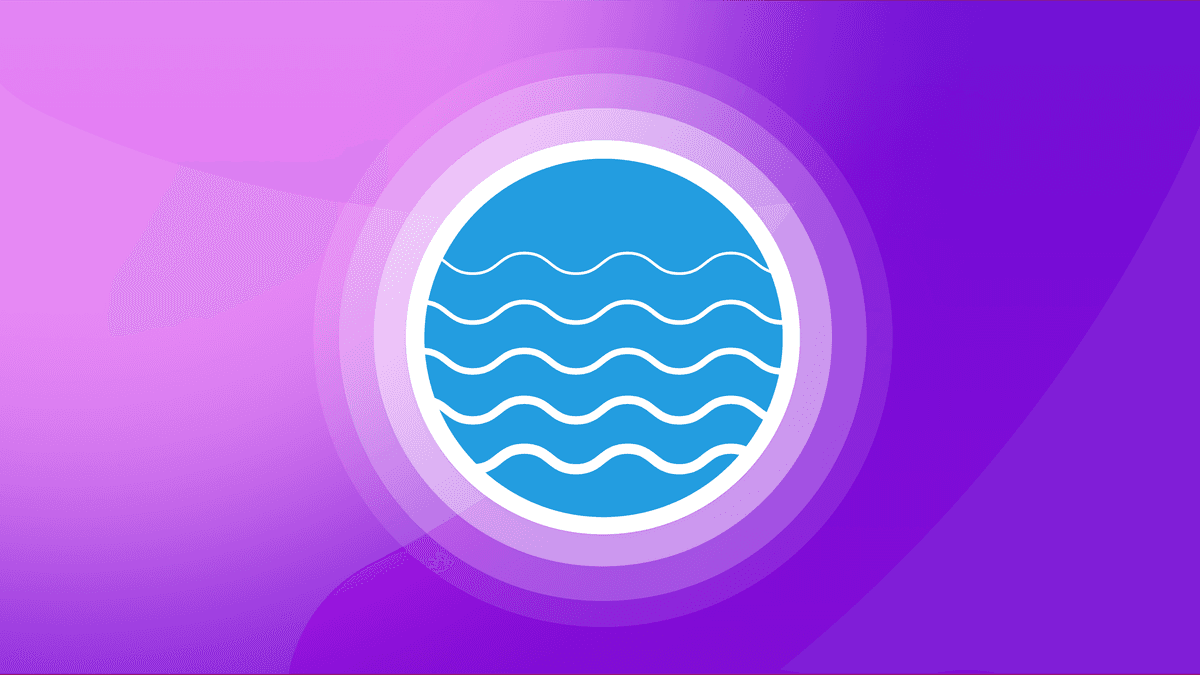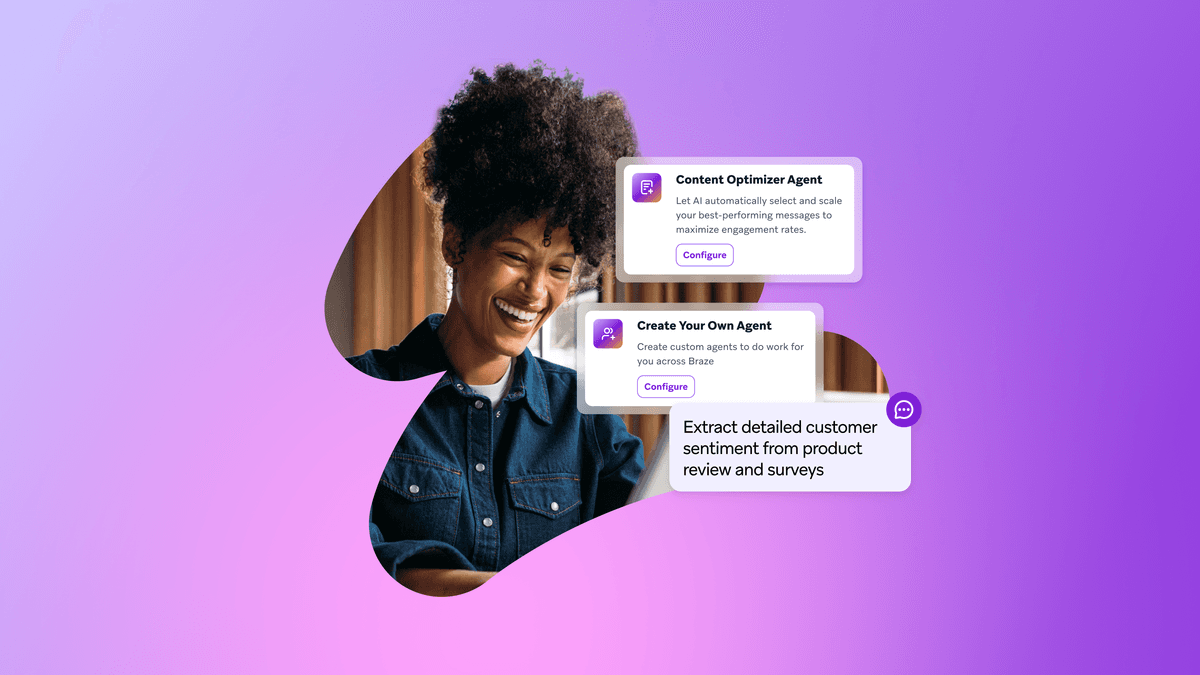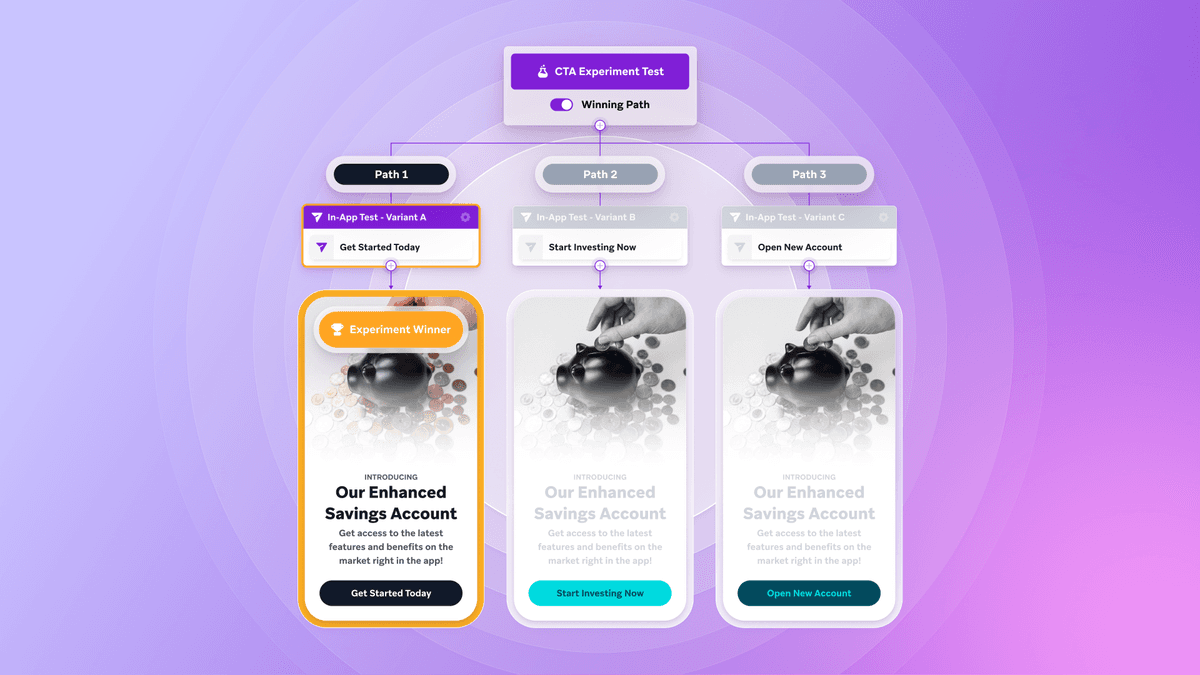App Uninstalls: A Totally Unscientific Look at What Makes Customers Pull the Plug
Published on January 21, 2016/Last edited on January 21, 2016/9 min read

Published on January 21, 2016/Last edited on January 21, 2016/9 min read


People uninstall apps all the time. You’ve done it. I’ve done it. But while it’s always painful when a customer decides to step away, the better your brand understands why they’ve chosen to uninstall, the better positioned you’ll be to retain the rest of your audience and potentially win back some of the customers you’ve lost.
We talked to 22 employees here at Appboy about the last app they uninstalled: how long they used it, what prompted them to disengage, and whether there’s anything that those brands could do to win them back. We heard stories that speak to huge pitfalls in the app/user relationship, ones that you might recognize as an app consumer, as a marketer, or both. While this small sample size—22 people who work in the mobile app business and live in either New York or San Francisco—is pretty unscientific from a stats perspective, these stories are very illuminating as anecdotes. Let’s take a look.
Here’s what we found…
The 22 apps uninstalled came from more than a dozen verticals. While no one app vertical dominated the results, the most common verticals for uninstalls were music, games, and photo & video apps—each one of those categories accounted for 13.6% of the total.
45.4% of respondents uninstalled after one month or less, while 54.5% uninstalled more than a month after download. At the extremes, one person uninstalled an app within five minutes of downloading it because they were unwilling to create an account without being allowed to try the app first, while someone else kept an app on their phone for two full years before frustration over the repetitive and irrelevant messages they were receiving from it finally drove them to uninstall.
Respondents identified nine different reasons that drove their decision to uninstall, but three of those factors were associated with more than two-thirds of the uninstalls:
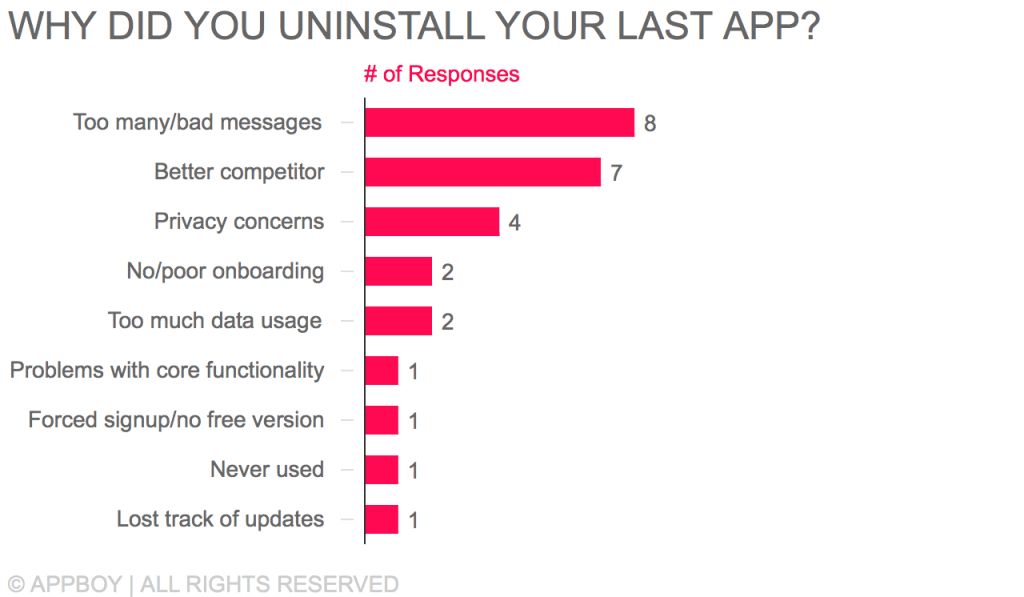
1) 29.6% of uninstalls were connected to problems with messaging
Too many push notifications or other messages. Irrelevant outreach. Messages based on outdated data. Generic messaging blasts that could have been personalized—but weren’t.
2) 25.9% of uninstalls were driven by problems with the app’s core functionality
Brands that stop updating their apps. Apps that crash mid-session. Confusing, frustrating user experiences. Difficulties understanding an app’s value or purpose.
3) 14.8% of uninstalls were the result of customers switching to a rival app
Brands whose apps fell behind competitors. Apps with usability problems that lost out to rival apps that were easier to use.
Other factors that were highlighted by our respondents as playing a role in their decision to uninstall an app were:
While only 18.2% of the people we spoke to ruled out returning to the app they’d uninstalled, most respondents expressed little interest in giving them another shot. Interestingly, though, one Appboy employee reported that she actually had already re-installed the last app she uninstalled (read on for the story).
In their own words: Appboy employees on the last app they uninstalled
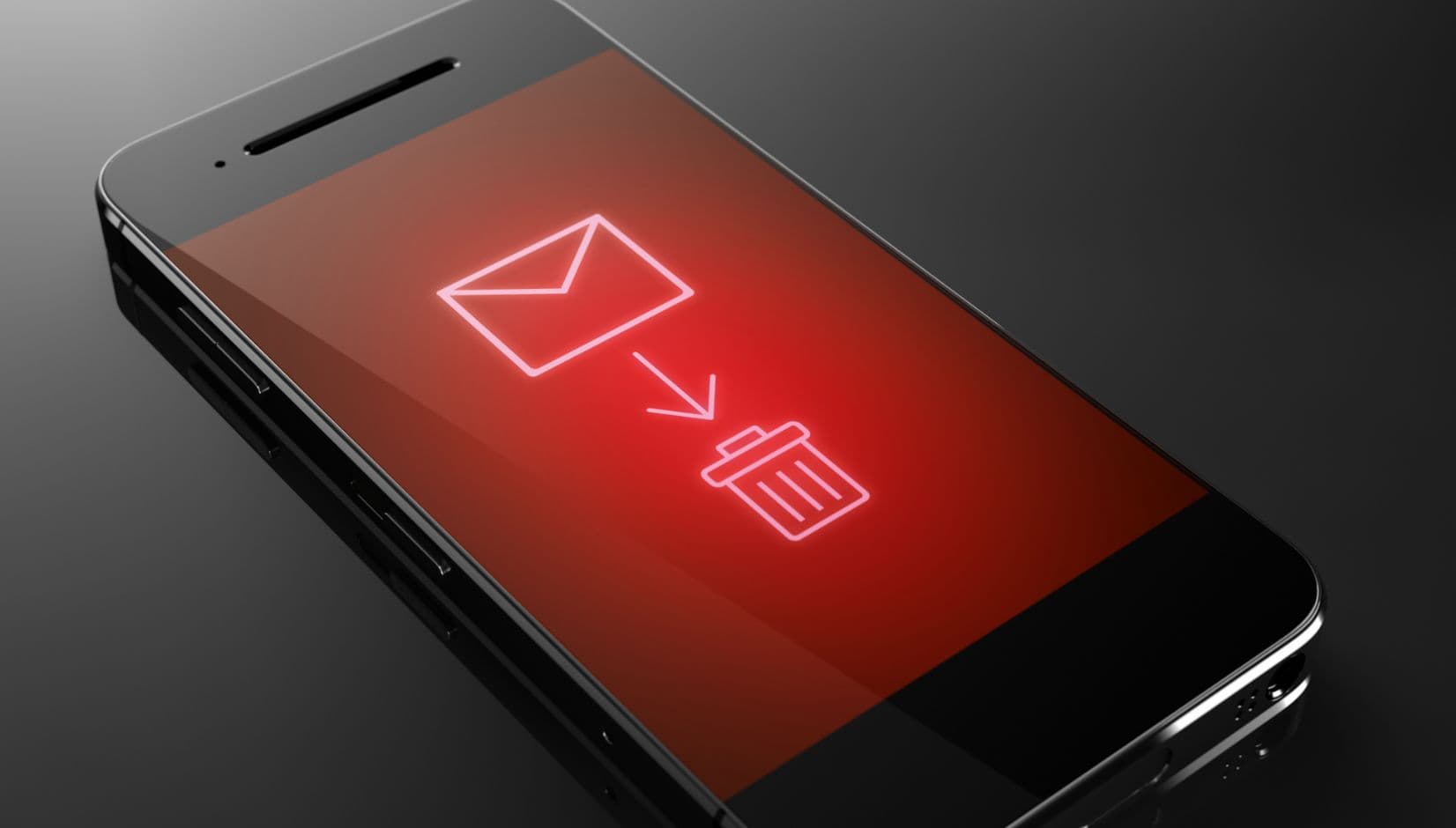
Liann Sun, Appboy software engineer, on the game app she uninstalled:
“I enjoyed playing the game when I first downloaded it, but then moved on to other things. Out of nowhere, months after I became disengaged with the app, I started getting weekly push notifications from them. After a few of these, I uninstalled.”
Marc Ioli, Appboy account executive, on the sports app he uninstalled:
“I kept receiving push notifications and emails for Golden State Warriors games despite having not been in Northern California in 6 months. The app gave me no option to manually override my location and also started sending me New York City notifications now that I reside in New York. Stop sending me Warriors push notifications when I’m on the East Coast!”
Preston Thompson, Appboy software engineer, on the entertainment app he uninstalled:
“The app wasn’t very intuitive to use and they kept sending me push notifications about shows they were live-streaming that I didn’t care about. In fact, I wasn’t even aware that live-streaming was a feature until they sent me one of those notifications. Some sort of onboarding strategy to educate me about how to use the app would have been helpful.”
Niki Castle, Appboy software engineer, on the shopping app she uninstalled:
“I was getting spammed with notifications even though I hadn’t really taken any actions, and didn’t feel they were relevant to me. Meanwhile, I was content with other options in the same space, so I didn’t care enough to try to make it work. However, I reinstalled a month ago while looking for a specific item of clothing and started using it a little more—I’ve made one purchase to date. Once you’ve marked a bunch of stuff that you might be interested in, you get relevant notifications when their prices are lowered. Now that I use it, I made the effort to turn off the notifications I don’t care about, but if an app I’m not really using is spamming me, I’ll probably just uninstall rather than trying to navigate their settings.”

Dylan Petro, Appboy software engineer, on the productivity app he uninstalled:
“The app had a really cool concept (track your email attachments, better categorize emails), but it didn’t do the important things super well: search, reliability, switching between accounts. For productivity apps, especially for email, I feel like it’s essential to do the core functionality right. If it was more stable, I’d try again.”
Samantha Hatz, Appboy office manager, on the health & fitness app she uninstalled:
“I was using the app to track the distance I was running when I began training for a half marathon. I started having issues with the app in the middle of runs—it would close out and quit, or say I had run a mile in 2 minutes. It was making it very difficult to track my progress and maintain a steady training schedule. I was able to find another fitness app (which was also free) to replace this app. I’ve never had a problem with this new one, and there are added perks such as a ‘running coach’ which created an entire training program and sends me push notifications reminding me of upcoming runs.”

Chris Pulliam, Appboy operations analyst, on the finance app he uninstalled:
“I downloaded it to quickly transfer money to a friend. The app worked as I expected, which was great. Then later I saw the app had posted the transaction on Facebook for all my connections to see. I immediately uninstalled, and downloaded a less invasive competitor. I’m sure there is some setting in the app to turn it off, but my trust had already been violated.”

Mirabella Katz, Appboy marketing associate, on the music app she uninstalled:
“There was no try-before-you-buy option for the app. Unlike its competitors, this app doesn’t let you do anything until you sign up for a free trial (which charges you if you don’t cancel in time). The app itself was difficult to use and the layout was not user-friendly at all. They also didn’t personalize any of their messages despite knowing what music I listen to and what type of phone I use.”
Rocky Lotito, Appboy business development representative, on the sports app he uninstalled:
“The app’s alert settings meant I could either receive no push notifications, or dozens of pushes a day about every single piece of news on my favorite teams, with nothing in between. I wound up switching to another app that has much more balanced alerts.”
Jordan Houghton, Appboy marketing associate, on the music app she uninstalled:
“I was interested in the app, but was also trying out a competitor at the same time to see which service better suited me. The onboarding experience was severely lacking and I didn’t fully understand what I could do with the tier I’d signed up for. The app was difficult to manage and wasn’t worth my exasperation (I was emailed and messaged multiple times a day without receiving any actionable information). If they’d provided educational content, I would have been much more appreciative.”
What does it all mean?
Building lasting, sustainable customer/brand relationships can be difficult.
While relevant, actionable customer outreach can be the cornerstone of a successful audience engagement and retention strategy, brands that send too many messages (or irrelevant ones) are running the risk of alienating the recipient, potentially driving up uninstalls. And if your brand’s app has issues with its core functionality or isn’t delivering on its brand promise, you’re not just risking uninstalls—you’re also giving your competitors an opportunity to swoop in. Customers have a lot of options when it comes to the apps they use and brands that don’t put the necessary time and thought into crafting an experience that their audience finds valuable and engaging may well find that audience slipping away.
What to do about it
Each of these reasons to uninstall can be inspiration for a more successful approach. Make messaging personalized, relevant, timely, and don’t bombard your users. Put extra thought into the onboarding experience. Make permissions transparent and easy to use, and be sensitive to sharing user information. Keep users informed about app updates with in-app messages or News Feed Cards.
In today’s mobile-centric world, long-term business success is about finding ways to hold onto your audience. Every customer that your brand retains is just as valuable to your bottom line as a newly acquired customer—more valuable, really, since the base of personal data that you’ve collected over time can be used to successfully power personalized, targeted outreach that makes it easier to engage and monetize them.
Sign up for regular updates from Braze.
